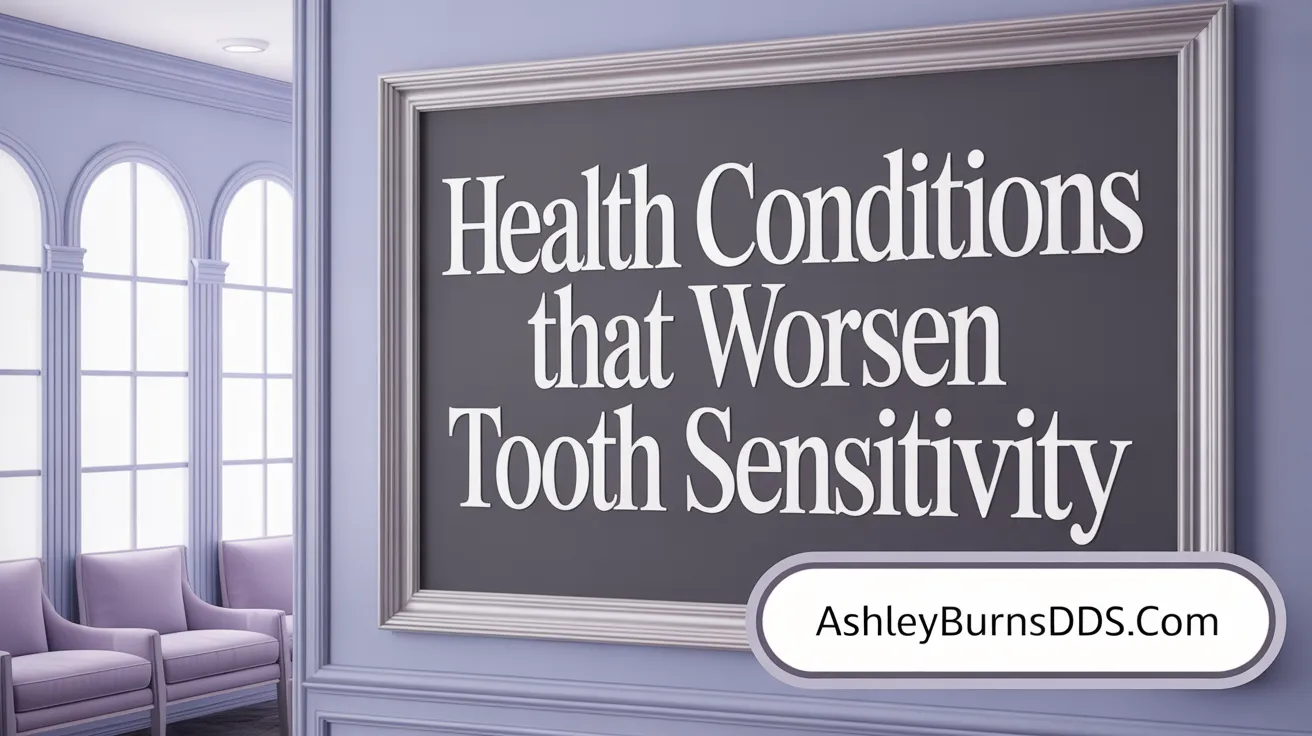Understanding the Growing Concern of Tooth Sensitivity
Tooth sensitivity, often characterized by sharp, sudden pain triggered by hot, cold, sweet, or acidic stimuli, affects millions of people worldwide and can significantly impact daily life. This article explores the most common causes of tooth sensitivity based on recent scientific research, examining the biological mechanisms, contributing factors, and current strategies for prevention and treatment to provide readers with a comprehensive understanding of this widespread dental issue.
Common Causes of Tooth Sensitivity: From Enamel Erosion to Gum Recession

What are the common causes of tooth sensitivity?
Tooth sensitivity often results from damage or wear to the protective outer layers of teeth. The most frequent cause is enamel erosion, which exposes the dentin underneath. This can happen due to acids from foods and beverages like citrus, wine, and sodas, which gradually demineralize enamel (Impact of acidic foods on teeth).
Aggressive brushing with a hard toothbrush or using abrasive toothpaste can physically wear down enamel, increasing vulnerability (brushing with too much force). Habits such as teeth grinding (bruxism) and certain dental procedures, like whitening treatments or restorations, can also temporarily or permanently expose sensitive dentin (Teeth grinding and sensitivity).
Gum recession is another major factor. When gums recede, they expose the roots of the teeth, which lack the enamel protective layer (Gum recession impact. This exposes tiny tubules in the dentin, leading directly to nerve endings, and causes sensitivity.
Cavities, cracked or chipped teeth, and worn fillings can also lead to sensitivity by creating pathways for stimuli to reach the nerve (Common causes of sensitive teeth). Furthermore, conditions like TMD (temporomandibular disorder) and habitual clenching can damage tooth structures over time (Managing tooth sensitivity).
Maintaining good oral hygiene practices—such as gentle brushing with a soft-bristled toothbrush, limiting acidic foods, and visiting the dentist regularly—is essential to prevent or alleviate sensitivity caused by these factors (Oral hygiene practices for sensitive teeth).
Recent research emphasizes the importance of identifying individual causes of sensitivity to tailor effective treatment strategies, highlighting the role of protective agents like fluoride and innovative remineralization products (Dentinal hypersensitivity overview and treatment).
The Biology Behind the Pain: Understanding Dentin Hypersensitivity

What biological and physiological factors contribute to tooth sensitivity?
Tooth sensitivity, technically called dentin hypersensitivity, occurs when the protective outer layers of the teeth, enamel and cementum, wear away or are damaged. This exposes the underlying dentin, which contains microscopic tubules or channels that connect directly to the pulp or nerve tissue inside the tooth.
The dentin is a critical component in understanding sensitivity because these tiny tubules serve as pathways for stimuli—such as heat, cold, or sweet substances—to reach the nerve endings. When exposed, even minor stimuli can cause fluid movement within these tubules, which then triggers the nerves to send pain signals. For an overview of the causes of tooth sensitivity, see this resource.
The structure of dentin and its tubules
Dentin is made of mineralized tissue, and its tiny tubules house liquid and cellular processes. These tubes are connected to the pulp chamber—where nerves and blood vessels reside. They act as conduits for stimuli, transmitting thermal, chemical, or tactile changes to the nerve endings. This aspect relates to the evolution and sensory function of dentine and tooth structures.
Hydrodynamic theory of pain
The most widely accepted explanation for how stimuli evoke pain in sensitive teeth is the hydrodynamic theory of pain. According to this theory, external stimuli cause rapid movement of fluid within the exposed dentinal tubules. This fluid movement then stimulates the nerve fibers located near the pulp, resulting in a sharp pain sensation. For example, when you sip a hot coffee or bite into something cold, the resulting fluid shift activates nerve endings, causing the characteristic discomfort.
Nerve activation through exposed dentin
Nerves inside the tooth are shielded by enamel or cementum, but once these layers are compromised, the exposed dentin becomes directly sensitive. The tiny tubules contain nerve terminals or are close enough that the fluid movement stimulates these nerves. Thus, even slight temperature shifts or chemical changes (like sugar or acids) cause immediate nerve responses. Learn more about nerve activation and dentinal hypersensitivity.
Relationship between enamel loss and nerve sensitivity
Enamel acts as a natural shield, protecting the dentin and preventing stimuli from reaching the nerve endings. When enamel erodes due to factors such as acidic foods, vigorous brushing, or wear and tear, the dentin becomes exposed. This exposure significantly increases the likelihood of stimuli causing pain because the nerve-rich dentin is now accessible to external triggers. For detailed information on how enamel wear contributes to pain and tooth sensitivity, see this source.
Understanding this biological process highlights the importance of protecting enamel and addressing gum recession or wear early through proper dental care and treatments. Preventing exposure of the dentin itself is essential in managing and reducing tooth sensitivity.
Dental and Health Conditions That Exacerbate Tooth Sensitivity
 Several dental and systemic health conditions can worsen tooth sensitivity by damaging or exposing the internal structures of the teeth. Gum disease, such as gingivitis or periodontitis, often causes gum recession, which reveals the roots of the teeth—these areas lack protective enamel, making them highly sensitive to temperature and touch.
Several dental and systemic health conditions can worsen tooth sensitivity by damaging or exposing the internal structures of the teeth. Gum disease, such as gingivitis or periodontitis, often causes gum recession, which reveals the roots of the teeth—these areas lack protective enamel, making them highly sensitive to temperature and touch.
Dental decay and cavities erode the tooth enamel and expose the inner dentin, leading to sharp pain when consuming hot, cold, or sugary foods. Cracked or broken teeth can also expose sensitive tissues, increasing discomfort.
Worn out restorations like fillings or crowns may expose underlying dentin, causing heightened sensitivity. Additionally, excessive consumption of acidic foods and drinks like citrus, soda, or wine can accelerate enamel erosion, further exposing the sensitive dentin layers.
Behavioral factors such as aggressive brushing—using too much force or a hard-bristled brush—can physically wear down enamel and contribute to sensitivity. Teeth grinding (bruxism) also leads to enamel wear and gum recession.
Recent dental procedures, including cleanings, fillings, or whitening treatments, may temporarily increase sensitivity by disturbing the tooth surface or exposing dentinal tissues.
Poor oral hygiene habits, such as inadequate brushing or flossing, can lead to plaque buildup. Plaque erodes enamel and gums, resulting in increased sensitivity and risk of infections.
Lifestyle choices like smoking and diet can influence oral health status, compounding problems related to sensitivity.
Preventive measures, including gentle brushing with a soft brush, fluoride application, and regular dental checkups, can help protect the teeth from these damaging conditions. Treatments like dental bonding, sealants, or gum grafts are effective options to manage cases where the roots are exposed or the enamel has significantly eroded.
In summary, maintaining good oral hygiene, avoiding aggressive brushing, limiting acidic food intake, and seeking prompt dental care when issues arise are crucial in reducing the risk and severity of tooth sensitivity caused by these dental and health conditions. For more information, see Sensitive teeth treatment options and Causes of tooth sensitivity.
Oral Hygiene and Lifestyle Factors Influencing Tooth Sensitivity

What factors related to oral hygiene practices affect tooth sensitivity?
Improper oral hygiene habits play a significant role in the development and worsening of tooth sensitivity. Brushing too hard with a hard-bristled toothbrush can wear down the protective enamel layer, exposing the sensitive dentin underneath. Using abrasive toothpastes, especially those designed for whitening, can similarly erode enamel over time. Irregular or infrequent dental cleanings may allow plaque buildup and tartar to accumulate, leading to gum inflammation and recession. This recession exposes tooth roots, which lack enamel and are highly sensitive to stimuli.
How does aggressive or improper brushing impact teeth?
Vigorous brushing, particularly with excessive force, damages enamel and causes gum recession. This not only exposes the underlying dentin but also increases the risk of developing cracks or chips in the teeth, which can lead to additional sensitivity.
What is the effect of abrasive toothpastes?
Abrasive toothpastes contain particles that help polish teeth but can also accelerate the wearing away of enamel if used excessively or with too much pressure. This weakening makes teeth more vulnerable to stimuli and increases sensitivity. Use of desensitizing toothpaste may be beneficial.
How does the consumption of acidic and sugary foods and drinks influence sensitivity?
Consuming acidic foods and beverages, such as citrus fruits, soda, or sour candies, can erode enamel through demineralization. The softened enamel makes it easier for acids to reach dentin and nerves, resulting in pain or discomfort when eating or drinking. The impact of acidic foods on teeth is well-documented, and limiting their intake or rinsing afterward can help reduce sensitivity.
What is the impact of teeth grinding and use of mouthguards?
Teeth grinding, or bruxism, wears down enamel and can lead to tooth fracture, recession, and exposure of sensitive dentin. Wearing a mouthguard during sleep helps protect teeth from the mechanical forces of grinding, thus reducing the risk of sensitivity.
Why are regular dental visits and professional care important?
Routine dental check-ups enable early detection and treatment of issues like cavities, gum disease, and enamel erosion. Professional cleanings remove plaque buildup, reduce the risk of recession, and help maintain the protective enamel layer. Dentists can also apply fluoride varnishes or sealants that strengthen enamel and decrease sensitivity.
| Factors | Effects | Preventive Measures |
|---|---|---|
| Aggressive brushing | Enamel and gum damage, root exposure | Use gentle brushing, soft-bristled toothbrushes |
| Abrasive toothpastes | Enamel wear, increased sensitivity | Choose desensitizing toothpaste, avoid harsh products |
| Acidic foods and drinks | Enamel erosion, dentin exposure | Use straws, rinse with water after consumption, limit intake |
| Teeth grinding (bruxism) | Enamel wear, recession, dentin exposure | Use mouthguards, reduce stress, avoid stimulating substances |
| Infrequent dental visits | Plaque buildup, untreated decay, gum disease | Schedule regular dental check-ups, professional cleaning |
Understanding how daily practices impact tooth health is essential. Proper brushing technique, diet, and regular dental care help safeguard against sensitivity and preserve a healthy, pain-free smile.
Current Advances in Prevention, Management, and Treatment of Tooth Sensitivity
 Tooth sensitivity, also known as dentin hypersensitivity, is a common dental concern that can significantly affect daily life. Recent developments offer a range of strategies focused on both prevention and active treatment.
Tooth sensitivity, also known as dentin hypersensitivity, is a common dental concern that can significantly affect daily life. Recent developments offer a range of strategies focused on both prevention and active treatment.
One of the main approaches in managing sensitivity is the regular use of desensitizing toothpastes containing ingredients like potassium nitrate, strontium chloride, or stannous fluoride. These compounds work by blocking nerve signals or sealing the exposed dentinal tubules, reducing pain over time.
Fluoride treatments are also pivotal. Dentists frequently apply fluoride varnish, gel, or foam to help rebuild mineral content and strengthen enamel, providing a protective barrier against stimuli.
For more targeted interventions, dental bonding and sealants can cover exposed roots or large areas of dentin. Gum grafts may be necessary when gum recession exposes sensitive root surfaces, effectively covering the area and restoring tissue support.
Managing behavioral factors such as teeth grinding is crucial. Wearing custom-fit mouthguards at night can prevent wear and further recession, maintaining enamel integrity.
Patient education plays a vital role. Advising patients on gentle brushing techniques, the importance of soft-bristled toothbrushes, and avoiding acidic foods and drinks reduces risk factors. Lifestyle modifications, like limiting intake of citrus, wine, or sodas, and quitting smoking, support long-term oral health.
Emerging research highlights advances in remineralization agents such as NovaMin, a bioactive glass that bonds with tooth structure to form a natural mineral layer, sealing dentinal tubules and offering relief from sensitivity. These agents not only diminish pain but also promote natural repair and strengthen the teeth.
Overall, a combination of preventive measures, professional dental treatments, and ongoing patient education forms the foundation of current strategies to effectively control and reduce tooth sensitivity, ensuring better quality of life for affected individuals.
Taking Control of Tooth Sensitivity with Knowledge and Care
Tooth sensitivity is a complex condition influenced by a combination of biological, dental, and lifestyle factors. Recent research underscores the importance of understanding enamel erosion, dentin exposure, and the impact of oral hygiene and health conditions in causing sensitivity. By adopting preventive measures such as gentle brushing, managing dietary acids, and utilizing advances in dental treatments, individuals can effectively manage and reduce sensitivity. Regular dental visits and tailored professional interventions remain essential to address underlying causes and improve quality of life. Empowered with scientific insight, patients can take proactive steps to protect their dental health and minimize the discomfort of sensitive teeth.
